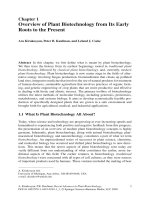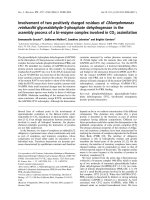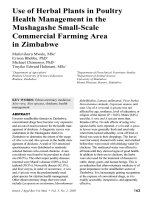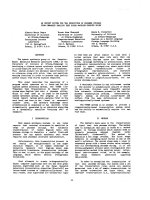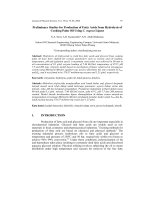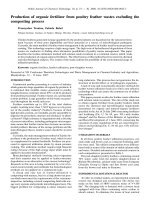Production of organic fertilizer from poultry feather wastes excluding the composting process
Bạn đang xem bản rút gọn của tài liệu. Xem và tải ngay bản đầy đủ của tài liệu tại đây (623.13 KB, 4 trang )
Pol. J. Chem. Tech., Vol. 10, No. 2, 2008 33Polish Journal of Chemical Technology, 10, 2, 33 — 36, 2008, 10.2478/v10026-008-0025-3
Production of organic fertilizer from poultry feather wastes excluding the
composting process
Przemys³aw Tronina, Fabiola Bubel
Poltegor-Institute, Institute of Surface Mining, Wroc³aw, Poland, e-mail:
Chicken feathers generated in large quantities by the poultry industry are hazardous for the natural environ-
ment because of their poor digestibility and their potential as a source of microbiological pathogens.
Currently, the main method of feather waste management is the production of feather meal by steam pressure
cooking. This technology requires a high energy input. The high costs of hydrothermal degradation of these
wastes are conducive to finding other alternative possibilities of poultry wastes management. This paper
describes the feather-utilization method with calcium oxide treatment in a rotational reactor, which leads
to the production of organic-mineral fertilizers. The effectiveness of this method has been tested in chemical
and microbiological analyses. The results of the study confirm the possibility of the environmental usage of
utilization-products.
Keywords: organic fertilizer, feather utilization, post-slaughter wastes.
Presented at VII Conference Wasteless Technologies and Waste Management in Chemical Industry and Agriculture,
Miêdzyzdroje, 12 – 15 June, 2007.
INTRODUCTION
Commercial poultry processing is a sector of industry
which generates large quantities of organic by-products. It
is estimated that inedible wastes generated in poultry
slaughterhouses constitute about 89% of all by-products
from poultry processing
1
. Feather wastes are a particularly
serious problem. Large quantities of this waste are gener-
ated throughout the world each year.
Feathers constitute up to 10% of the total chicken
weight, reaching more than 7,7x10
8
kg/year as a by-prod-
uct of the poultry industry
2
. Feathers, because of their
high keratins content, are insoluble, poorly susceptible to
digestion by proteolytic enzymes and chemical- or physi-
cal factors
3
. High resistance to degradation and a diversity
of present microflora, including pathogenic microorgan-
isms, means that feather wastes have become an environ-
mental problem. Because of the storage problems and the
microbiological threat, feather wastes should be treated
quickly.
Currently, the main management method of feather by-
products is the production of feather meal, which is used
as a supplement for animal feedstuffs. Feathers are proc-
essed in approved utilization plants by steam pressure
cooking. The utilization method requires high financial
outlays because of the high energy input which must be
applied to keratins denaturation
4
.
Biotechnological methods involving micro-organisms
and their enzymes may be applied to feather-structure
degradation as an alternative to the current technology
5
.
Research in this area is being conducted by a lot of re-
search centers locally and worldwide but biotechnological
methods are not applied on a commercial scale.
A cheap and easy way of feather-utilization is
composting with manure, but it is a long-drawn-out proc-
ess which must meet the requirements of the veterinary-
inspection, including a closed composting field with sew-
age carry systems and periodic microbiological tests. The
biggest problem for composting is odour emission and
long endurance. This process does not guarantee the de-
struction of keratin fibers or of pathogenic organisms.
A lack of easy and economically attractive methods for
feather wastes utilization leads us to find a new effective
technology which can assure the common use of utiliza-
tion products.
This paper presents an idea for feather-waste utilization
with calcium oxide treatment. The aim of this study was
to obtain organic fertilizer from poultry feathers which
meets the chemical and microbiological requirements
determined for organic and mineral-organic fertilizers
specified in the Act of 26 July 2000 concerning fertilizers
and fertilizing (Dz. U. Nr 89, poz. 991) with further
changes
6
and the Decree of the Minister of Agriculture
and Rural Development of 1 June 2001, concerning the
execution of some regulations of the act concerning fer-
tilizers and fertilizing (Dz. U. Nr 60, poz. 615) with fur-
ther changes
7
.
UTILIZATION MATERIALS
In all three poultry feather utilization processes, cal-
cium oxide and brown coal as a mineral fertilizing addi-
tive were used. The utilized compositions were differen-
tiated only in terms of the amount of added calcium oxide
and water. Detailed information on materials content in
each composition is presented in Table 1.
The post-slaughter poultry feathers, containing around
70% water, came from the poultry slaughter-house in
Bielany Wroc³awskie, calcium oxide came from Company
Góra¿d¿e Group in Opole and fine brown coal came
from the brown coal mine in Sieniawa.
EXPERIMENTAL ROTATIONAL REACTOR
In order to conduct studies, an experimental rotational
reactor was designed and constructed. The device was
made on the basis of H095 concrete mixer of V=200
dm
3
. The charging hole is fastened with a closure head
equipped with four filters containing active carbon to
absorb odours. To eliminate the losses of heat emitted
34 Pol. J. Chem. Tech., Vol. 10, No. 2, 2008
Figure 2. The scheme of the closure head
Figure 1. The scheme of the reactor
Table 1. Utilization compositions
1 – reactor's tumbler 5 – reactor's drive
2 – closure head 6 – frequency converter
3 – undercarriage 7 – toothed ring
4 – polyurethane foam 8 – active coal filters
during the composting process, the tumbler was covered
with an additional layer of polyurethane foam. The reac-
tor was equipped with a VLT 2800 frequency converter
that made it possible to modify the reactor's speed and
sense of rotation. The scheme of the reactor is presented
in Figs. 1 and 2.
UTILIZATION PROCESS DESCRIPTION
After filling the reactor with the components in propor-
tions presented in Table 1., the closure head was sealed
and the reactor was turned on. After initial mixing, the
rotational speed of the reactor was established at the level
of 15 rpm. The estimated time of calcium oxide transfor-
mation during the utilization was 2 hours. During the
process, calcium oxide bound water from the post-slaugh-
ter poultry feathers in a hydration reaction. A lot of heat
was released during the exothermic reaction of hydration
causing the temperature to rise up to over 80
o
C due to
the reaction scheme:
CaO + H
2
O → Ca(OH)
2
+ Q
After terminating the process and cooling down the
reactor, the final product of the utilization was unloaded,
mechanically shredded and transferred to a storage prism.
CHEMICAL AND MICROBIOLOGICAL TESTS
In order to estimate the content of the fertilizing com-
ponents, toxic metals and microbiological safety of the
utilization products, the samples of those final prepara-
tions were tested at the Institute of Soil Science and Plant
Cultivation in Pu³awy.
Chemical analyses were conducted according to internal
laboratory procedures at the Central Laboratory of Chemi-
cal Analyses in Pu³awy. Microbiological studies were per-
formed at the Department of Agricultural Microbiology
following the procedures based on norms PN-Z-19000-1
8
and PN-Z-19000-4
9
.
RESULTS AND DISCUSSION
The results of the chemical and microbiological tests of the
final utilization products are presented in Tables 2 and 3.
A lot of heat was released during the exothermic reac-
tion of „slacking”. The high temperature (>80
o
C) and
strongly alkaline environment (pH>12) during the proc-
ess caused the inactivation of pathogens in feathers. The
conducted microbiological test showed that the proposed
utilization technology efficiently inactivates Salmonella
pathogens whose presence in fertilizers is forbidden ac-
cording to the current law. Also, no live eggs of the inva-
sive parasites Ascaris spp., Trichuris spp. or Toxocara spp.
were found, which confirms the effectiveness of the tech-
nology used.
Utilization products were also characterized by the
several times lower content of toxic elements than deter-
mined in the Decree of the Minister of Agriculture and
Rural Development of 1 June 2001, concerning the ex-
ecution of some regulations of the act concerning fertiliz-
ers and fertilizing (Dz. U. Nr 60, poz. 615) with further
changes. The content of copper was on average 60-times
lower and nickel 9-times lower than the amounts described
in the regulations.
Essential nutrient elements, such as nitrogen, phospho-
rus, potassium, magnesium, calcium and sodium, were
found in the final utilization products, which may suggest
a positive influence of those preparations for plant growth.
Additionally, their alkaline reaction gives those prepara-
tions an additional feature, that of soil deacidification.
The high content of the organic matter (>50%) in
those products is also worth mentioning. Its positive in-
fluence reveals itself in gathering the nutrient components
and stops them from being washed out. As an additional
Pol. J. Chem. Tech., Vol. 10, No. 2, 2008 35
source of organic matter, especially humic acids, posi-
tively influencing physical and sorption characteristics of
the products, fine brown coal was added
10
.
Directly after emptying the reactor, the water content
in the final utilization product was abundant. Storing in
a prism makes it possible for excess water to evaporate
and as a result improve the consistency of the preparation,
which is vital for soil application.
Based on the conducted tests, the final utilization prod-
ucts received a positive opinion from the Institute of Soil
Science and Plant Cultivation in Pu³awy referring to the
environmental usage of those preparations. The real fer-
tilizing properties should be a matter of further vegetative
field tests.
CONCLUSIONS
1. The presented technology of poultry feather utiliza-
tion makes it possible to generate a product that fulfils the
requirements determined for the organic and mineral-
organic fertilizers specified in the Act of 26 July 2000,
concerning fertilizers and fertilizing (Dz. U. Nr 89, poz.
991) with further changes and the Decree of the Minister
of Agriculture and Rural Development of 1 June 2001,
concerning the execution of some regulations of the act
regarding fertilizers and fertilizing (Dz. U. Nr 60, poz.
615) with further changes. Final fertilizing preparations
received a positive opinion from the Institute of Soil
Science and Plant Cultivation in Pu³awy, referring to the
environmental usage of those products.
2. Minimum addition of 7% of calcium oxide made it
possible to generate the products meeting sanitary de-
mands.
3. The high content of the slowly released nitrogen and
other nutrient components along with the high pH of the
final products may suggest a good fertilizing usability of
the utilization products.
4. Technology described in this paper may be an eco-
nomical alternative to the recently used methods of feather
utilization.
The results presented in this paper were obtained within
the purposeful project no 6T092005C/06541 „Sludge and
organic wastes utilization technology development” financed
by Ministry of Science and Higher Education.
LITERATURE CITED
1. Rosik-Dulewska, Cz., (2006). Podstawy gospodarki
odpadami, Wydawnictwo Naukowe PWN, Warszawa.
2. Grazziotin, A., Pimentem, F.A., de Jong, E.V. & Brandelli,
A., (2006). Nutritional improvement of feather protein by treat-
ment with microbial keratinase, Animal Feed Science and Tech-
nology, 126, 135 – 144.
3. Rodziewicz, A. & £aba, W., (2006). Keratyny i ich
biodegradacja, Biotechnologia, 2 (72).
Table 2. The results of the chemical tests of the final utilization products
Table 3. The results of the microbiological test of the final utilization products
36 Pol. J. Chem. Tech., Vol. 10, No. 2, 2008
4. Praca zbiorowa pod redakcj¹ doc. dr hab. Tadeusza
Grabowskiego, (1993). Technologia miêsa drobiowego,
Wydawnictwa Naukowo-Techniczne, Warszawa.
5. Onifade, A.A, Al-Sane, N.A., Al-Musallam, A.A. & Al-
Zarban, S., (1998). A review: Potentials for biotechnological
applications of keratin-degrading microorganisms and their en-
zymes for nutritional improvement of feathers and other keratins
as livestock feed resources, Bioresource Technology, 66, 1 – 11.
6. Ustawa o nawozach i nawo¿eniu z dnia 26 lipca 2000 r.
(Dz. U. Nr 89, poz. 991) z póŸniejszymi zmianami.
7. Rozporz¹dzenie Ministra Rolnictwa i Rozwoju Wsi z
dnia 1 czerwca 2001 r. w sprawie wykonania niektórych
przepisów ustawy o nawozach i nawo¿eniu (DzU nr 60, poz.
615) z póŸniejszymi zmianami.
8. PN-Z-19000-1 Ocena stanu sanitarnego gleby –
Wykrywanie bakterii z rodzaju Salmonella.
9. PN-Z-19000-4 Ocena stanu sanitarnego gleby –
Wykrywanie jaj paso¿ytów jelitowych.
10. Maciejewska, A., (1998). Wêgiel brunatny jako Ÿród³o
substancji organicznej i jego wp³yw na w³aœciwoœci gleb, Oficyna
Wydawnicza Politechniki Warszawskiej, Warszawa.
